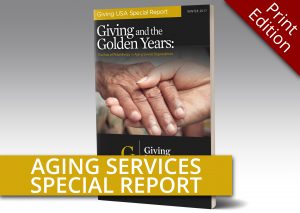A Giving USA report looks at the importance of philanthropy in the aging services sector
 By 2060, it is estimated that the population of Americans over 65 will climb to 98.2 million – double the estimated population in 2015, according to the U.S. Census Bureau. But a report from Giving USA Foundation questions how aging services organizations (ASO’s) will be able to fiscally bear that growth. A Giving USA Special Report, Giving and the Golden Years: The Role of Private Giving in Aging Services Organizations, available in print or digital download, provides a first-of-its-kind benchmark of the national aging services landscape. This includes information on state-by-state coverage and how these critical organizations are supported financially. The Giving USA Foundation hopes the report will allow organizations focused on serving aging populations to look at their current financial support and long-term trends to make decisions on how to ensure future financial stability.
By 2060, it is estimated that the population of Americans over 65 will climb to 98.2 million – double the estimated population in 2015, according to the U.S. Census Bureau. But a report from Giving USA Foundation questions how aging services organizations (ASO’s) will be able to fiscally bear that growth. A Giving USA Special Report, Giving and the Golden Years: The Role of Private Giving in Aging Services Organizations, available in print or digital download, provides a first-of-its-kind benchmark of the national aging services landscape. This includes information on state-by-state coverage and how these critical organizations are supported financially. The Giving USA Foundation hopes the report will allow organizations focused on serving aging populations to look at their current financial support and long-term trends to make decisions on how to ensure future financial stability.
Aging services organizations — nonprofits dedicated to serving aging populations — range from food programs and housing to adult day care, in-home services and nursing facilities. The report found that only six percent of nonprofit organizations in the country that file tax returns with the IRS are focused on providing services to aging populations. That is especially surprising, given 24.5 percent of American households are headed by someone 65 or older.
“This is a surprisingly small number of organizations meant to serve a large and still growing population of Americans,” said Aggie Sweeney, CFRE, Giving USA Foundation Board Chair. “We’re hoping the findings of this report will motivate the public to add aging services organizations to their annual giving portfolios.”
Insights on ASO Revenue
Within this small aging services sector, the report revealed ASO’s vary widely on revenue size. Over half of all aging service organizations operate with an annual revenue at or under $500,000. The exception is nursing facilities and home health services, of which nearly 30 percent operate with annual revenue of $10 million or more. These differences in business models and mission also create two extremes in their reliance on charitable giving:
- Organizations like food programs receive more than 82 percent of revenue through grants and contributions, including in-kind food donations.
- Nursing facilities and home health services receive less than five percent of total revenue through grants and contributions.
“Both of these models present risks to the organization by relying heavily on a single type of income,” said Nathan Dietz, report co-author and Senior Research Associate with the Urban Institute’s Center on Nonprofits and Philanthropy. “Developing diversified sources of revenue is one way to invest in the future.”
The report showed that many ASO’s have great opportunity to utilize charitable giving as a way to grow or diversify revenue. The report cautions, however, that investing in philanthropy takes time.
“Fundraising is not a simple or short-term solution,” said Laura MacDonald, CFRE, report co-author and Giving USA Foundation board member. “Long-term investments must be made by an organization’s leadership, management and the community at large. With patience and diligence, a sound fundraising program should eventually return $3 to $5 for every $1 invested.”
Alarmingly, the report also found that only 10 percent of ASO’s have an endowment fund of any kind. These funds are an investment commonly used by nonprofits, such as universities and hospitals, to ensure funding for future programs, operations, and services. They are most often established by generous donors who recognize the imperative to sustain the nonprofit organization’s essential mission.
Coverage State-By-State
The report revealed a clear disparity in ASO coverage when looking state-by-state. States commonly thought of as “retirement states” like Florida, Arizona, Texas and the Carolinas scored in the bottom 25 percent in the number of ASO’s per 1,000 residents 65 and older. By contrast, Minnesota, Nebraska and the Dakotas scored in the top 25 percent.
Philanthropy in Older Generations
Another irony that was brought to light in the report is the prevalence of philanthropy in older generations. Americans born before 1964 make up the most generous generation in the country, accounting for nearly 70 percent of all charitable giving in the U.S. It’s likely that this generation will be the biggest philanthropic supporter of aging services they may come to rely on.
###
The Giving USA Special Report, Giving and the Golden Years: The Role of Private Giving in Aging Services Organizations, can be purchased as a paperback book for just $29.95 or as a downloadable PDF for just $24.95 at www.GivingUSA.org.
About Giving USA Foundation
Advancing the research, education, and public understanding of philanthropy is the mission of the Giving USA Foundation, founded in 1985 by The Giving Institute. Headquartered in Chicago, the Foundation publishes data and trends about charitable giving through its seminal publication, Giving USA: The Annual Report on Philanthropy, and quarterly special reports on topics related to the field of philanthropy.


